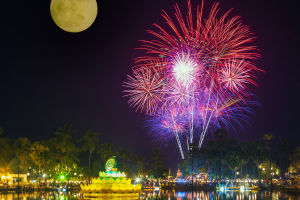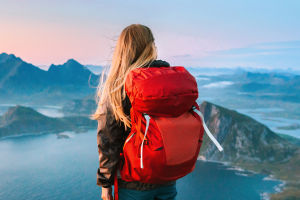Have you ever wondered what it feels like to step into one of the oldest deserts on Earth, where surreal landscapes meet rare wildlife?
The Namib Desert in Namibia offers just that—a mesmerizing experience filled with towering red sand dunes, eerie clay pans known as Dead Vlei, and remarkable opportunities to explore a truly unique ecosystem.
Let's dive into what makes this desert so special and how you can enjoy it firsthand.
Namib Desert
The Ancient Red Sands of Namib
The Namib Desert stretches along Namibia's Atlantic coast and is widely considered the oldest desert on the planet, with an age of at least 55 million years. One of its most striking features is the intense red sand that colors the landscape. This rich red hue comes from iron oxide coating the sand grains, creating a fiery backdrop that changes color throughout the day as sunlight shifts.
Among these sand giants, the dunes near Sossusvlei stand tallest—some reaching heights over 300 meters (almost 1,000 feet). Climbing these dunes, like the famous Dune 45, offers panoramic views that are absolutely unforgettable. It's a perfect activity for those who want a taste of adventure combined with stunning natural beauty.
Dune 45 is just 45 km (28 miles) from Sesriem gate, easily accessible by 2WD or 4WD. Climbing is free after park entry.
The Mystical Dead Vlei
One of the most captivating sights in the Namib Desert is Dead Vlei, a white clay pan dotted with ancient camel thorn trees. These trees have been standing lifeless for around 900 years but have not decomposed due to the dry climate. The contrast of the blackened trees against the bright white ground and the surrounding vivid red dunes creates an otherworldly scene that attracts photographers and travelers worldwide.
From the parking lot, reaching Dead Vlei requires a short 1.1 km (0.7 mi) walk through sand—wear sturdy shoes and avoid midday heat.
Wildlife in an Extreme Environment
Despite the harsh conditions, the Namib Desert is home to some extraordinary wildlife uniquely adapted to survive here. You might encounter oryx, springbok, and desert-adapted elephants, which have evolved behaviors to conserve water. The Welwitschia plant, often called a "living fossil," can live for over 1,000 years in this arid environment and is a botanical wonder worth seeking out.
Experts in desert ecology emphasize the importance of protecting this fragile environment. By visiting responsibly and supporting local conservation efforts, travelers can help ensure that the Namib Desert's unique ecosystem thrives for generations to come.
Visitor Information: Planning Your Trip
To explore the Namib Desert, the main gateway is the nearby town of Sesriem, which acts as the entrance to the Namib-Naukluft National Park. Park entry fees generally cost around namibian 80 (Namibian dollars) per person per day, with vehicles paying an additional fee. This is about $4.50 USD per person, plus around $2–3 USD per vehicle (prices vary slightly by exchange rate). Tickets can be purchased at the Sesriem reception.
The park is open daily from sunrise to sunset, typically around 6 a.m. to 6 p.m., depending on the season. Visiting early in the morning or late afternoon not only offers cooler temperatures but also the best lighting for photos.
Getting There and Staying Nearby
Most visitors fly into Windhoek, Namibia's capital, then take a scenic 4- to 5-hour drive to Sesriem. Alternatively, guided tours often include transportation from Windhoek and other major towns, making travel hassle-free. Rental cars in Namibia cost around $40–60 USD/day, and self-driving is safe with a 2WD for most dry seasons, though a 4WD is preferred for deeper sand areas.
Accommodation options range from luxury lodges with desert views, which offer stunning views and high comfort, to campsites for travelers seeking a closer connection to nature. Booking ahead is recommended, especially in peak season from May to October.
Luxury lodges range from $250–500 USD per night during high season.
Mid-range guesthouses start around $90–150 USD per night.
Sesriem campsites cost around $15–25 USD per person per night.
Local Cuisine and Cultural Experiences
While the desert itself is sparse, nearby towns offer delicious Namibian specialties and mahangu porridge made from pearl millet. Sampling local food is a great way to connect with Namibian culture after a day of desert adventure. Local meals at guesthouses and roadside cafés typically cost $4–10 USD, while lodge dinners are often included in the room rate or cost $20–30 USD à la carte.
Tips for a Safe and Enjoyable Visit
1. Stay hydrated: Desert heat can be intense; always carry plenty of water. Carry at least 2 liters (half a gallon) per person for short hikes—more if you're staying out all day.
2. Wear sun protection: Hats, sunscreen, and sunglasses are essential.
3. Respect the environment: Stick to marked paths to protect fragile dune vegetation.
4. Plan for limited cell service: Some areas have little or no mobile coverage, so prepare accordingly. Offline maps and a basic satellite navigation devices can be helpful for navigation.
Now that you know what makes the Namib Desert so mesmerizing—from its ancient dunes and haunting Dead Vlei to the surprising wildlife—would you dare to explore this timeless land? The desert's vast, quiet beauty invites you to slow down, reflect, and experience nature in its rawest form. A 3-day trip from Windhoek to Sossusvlei (self-drive with 2 nights lodging) typically costs around $400–700 USD total per person, depending on your level of comfort and activities chosen.
So why not take that step and witness one of Earth's oldest landscapes for yourself? Your unforgettable desert adventure awaits.


